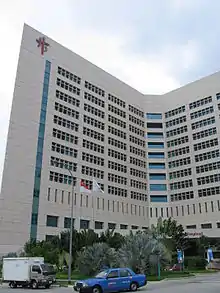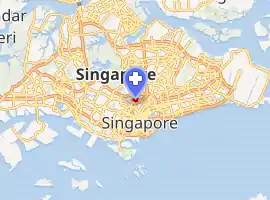Tan Tock Seng Hospital
Tan Tock Seng Hospital (Abbreviation: TTSH) is a tertiary referral hospital in Singapore, located in Novena. The hospital has 45 clinical and allied health departments, 16 specialist centres and is powered by more than 8,000 healthcare staff.
| Tan Tock Seng Hospital Hospital Tan Tock Seng (Malay) 陈笃生医院 (Chinese) தன் டாக் செங் மருத்துவமனை (Tamil) | |
|---|---|
| National Healthcare Group | |
 | |
 The new 15-story Tan Tock Seng Hospital was marked as a historic institution on 25 July 2001. | |

| |
| Geography | |
| Location | 11 Jalan Tan Tock Seng, Singapore 308433 |
| Coordinates | 1°19′17.8″N 103°50′45.4″E |
| Organisation | |
| Type | Teaching |
| Affiliated university | Lee Kong Chian School of Medicine, NTU |
| Services | |
| Emergency department | Yes |
| Beds | 1700 |
| History | |
| Opened | 25 July 1844 |
| Links | |
| Website | http://www.ttsh.com.sg |
TTSH is the flagship hospital of the National Healthcare Group and the principal teaching hospital for the NTU Lee Kong Chian School of Medicine. Its campus includes the National Centre for Infectious Diseases (NCID) and two national specialty centres, namely the National Skin Centre (NSC) and the National Neuroscience Institute (NNI).
History
In the 1820s, Singapore became established as a successful trading centre. Large numbers of immigrants came to the colony, hoping to make their fortune here. Many of these immigrants were poor and destitute, and malnutrition was common; it was estimated that about 100 immigrants died each year from starvation.
The British government set up a pauper's hospital in the 1820s but it closed in the 1830s because of insufficient funds. The government then suggested that the better-off members of each community take care of their own poor. Subsequently, some of the more benevolent members of the community responded. One such person was Tan Tock Seng, the acting Kapitan China of Singapore, a successful businessman and the city's first Asian Justice of Peace, who offered $5,000 for the construction of Singapore's first privately funded hospital.[1]
The foundation stone of the hospital, then called Chinese Pauper Hospital, was laid on 25 May 1844 on Pearl's Hill.[1] The building was designed by John Turnbull Thomson in a classical style.[2] Construction took three years and a shortage of funds saw the hospital stand empty for two more years. Finally, the first batch of patients was admitted in 1849. About 100 sick and destitute people had been housed in an attap shed at the foot of Pearl's Hill when a fierce storm destroyed the shed, and the patients were then moved to the hospital.[1]
In the hospital's early years, money was a constant problem, alleviated from time to time by donations from various benefactors, including other members of Tan's family and the general public. A shortage of staff and no reliable water supply also made things difficult. Tan Tock Seng died in 1850 at the age of 52. The hospital's name was changed to Tan Tock Sing Hospital (later spelt Tan Tock Seng in the 1850s).[1]
The hospital was moved a couple of times. In 1861, it was relocated to new premises on the corner of Serangoon Road and Balestier Road as the colonial government wanted to fortified the Pearl's Hill. A lepers' ward was also added. It was later decided that the low-lying ground on which the hospital stood was unsuitable for the patients, and in 1903, the land on Moulmein Road, where the present hospital stands, was bought with donation of $50,000 by Loke Yew. The new hospital was completed in 1909 by the Public Works Department.[1]
By the 1980s, the hospital's services and patient intake were beginning to outgrow the 1950s hospital building. A new 15-storey building was constructed and officially opened on 1 April 2000.[3]
As a result of a restructuring exercise in the local health-care scene, the hospital became a member of the National Healthcare Group in 2000.
Facilities
As one of the largest multi-disciplinary hospitals in Singapore, TTSH operates more than 1700 beds with centres of excellence including the National Centre for Infectious Diseases (NCID), Institute for Geriatrics & Active Ageing (IGA), NHG Eye Institute (NHGEI), TTSH Rehabilitation Centre, and Ang Mo Kio Specialist Centre (AMKSC).
TTSH's 600-bed Integrated Care Hub will be ready in 2022 to provide for subacute care and rehabilitation. As a healthcare leader in population health, systems innovation, health technologies and workforce transformation, TTSH hosts Singapore's largest purpose-built innovation centre for healthcare – the Ng Teng Fong Centre for Healthcare Innovation (CHI) and its Co-Learning Network of 37 local and international partners.
National Centre for Infectious Diseases
In 2003, the hospital was declared the designated hospital for SARS screening and treatment by the Ministry of Health due to its past experience with communicable diseases (the Communicable Disease Centre was located nearby) and was "effectively locked down" to contain the outbreak, which began with Esther Mok.[4] At the lobby of the hospital, a memorial plaque was dedicated in memory of the hospital's doctors and healthcare workers, two of whom died of the disease, who worked tirelessly during the SARS epidemic and Minister of Health Gan Kim Yong paid tribute to the hospital's staff.[4][5][6]
On 13 December 2018, the Communicable Disease Centre ceased operations as a medical facility, concluding its 121 years of operations.[7] All operations moved to the National Centre for Infectious Diseases, which was officially opened on 7 September 2019 by Minister for Health Gan Kim Yong. The 330-bed facility is designed to manage an outbreak of the size of the SARS outbreak, boasting state-of-the-art technologies. In addition, the facility tracks patients in the building to prevent the spread of outbreaks and houses Singapore's first high-level isolation unit for highly contagious, even lethal diseases like Ebola.[8]
National specialty centres
National Skin Centre
The National Skin Centre is an outpatient specialist dermatology centre. It handles a patient load of about 1,000 patients daily. It started its operations on 1 November 1988 after taking over the treatment of skin diseases from Middle Road Hospital. It provides specialised dermatological services, trains medical students and postgraduates, and undertakes research in dermatology and conducts continuing medical education for doctors and paramedical personnel.
National Neuroscience Institute
The National Neuroscience Institute (NNI) is the national and regional specialty centre for the management and care of neurological diseases in Singapore, providing treatment for a broad range of illnesses that affect the brain, spine, nerve and muscle. As the national and international centre of excellence in the neurosciences, its mission and goals rest upon three strengths – patient care, research and education.[9] Offering a comprehensive range of Neurology, Neurosurgery and Neuroradiology services, the NNI provides neuroscience care not only in Singapore but in the region.
The establishment of NNI in 1999 resulted in the transfers of the Department of Neurology and Neurosurgery from Tan Tock Seng Hospital (TTSH) to form the foundations of clinical service. A new department of Neuroradiology was also initiated to provide the specialised diagnostic imaging and interventional services for neurological diseases. Today, NNI has a campus co-located with SGH in Outram, but — unlike other SingHealth specialty centres — also has a campus located with Tan Tock Seng Hospital,[10] and provides specialty services to most other hospitals in Singapore as well.
References
- "Tan Tock Seng Hospital". Singapore Infopedia. National Library Board.
- Jane Beamish; Jane Ferguson (1 December 1985). A History of Singapore Architecture: The Making of a City. Graham Brash (Pte.) Ltd. p. 61. ISBN 978-9971947972.
- "Opening of Tan Tock Seng Hospital". NAS. 1 April 2000. Retrieved 29 December 2019.
- "Speech by Minister for Health Gan Kim Yong, at Tan Tock Seng Hospital "Remembering SARS: 10 Years On", 20 March 2013". Ministry of Health. 20 March 2013. Archived from the original on 1 July 2017. Retrieved 3 February 2015.
- "TTSH pays tribute to hospital workers who worked through Sars epidemic". The Straits Times. SPH. 20 March 2013.
- "TTSH Commemorates 10 Years Post SARS". ttsh.com.sg. 20 March 2013. Archived from the original on 3 February 2015. Retrieved 3 February 2015.
- Neo, Xiaobin (17 December 2018). "Farewell, Black Lion of Moulmein: Old compound of Communicable Disease Centre closes". The Straits Times. Retrieved 7 March 2019.
- Lai, Linette (7 September 2019). "New infectious disease centre tracks everyone in the building in case of outbreak". The Straits Times. Retrieved 7 September 2019.
- "Archived copy". Archived from the original on 31 July 2007. Retrieved 2 July 2007.CS1 maint: archived copy as title (link)
- "Archived copy". Archived from the original on 16 July 2007. Retrieved 3 July 2007.CS1 maint: archived copy as title (link)
- National Heritage Board (2002), Singapore's 100 Historic Places, Archipelago Press, ISBN 981-4068-23-3
| Wikimedia Commons has media related to Tan Tock Seng Hospital. |